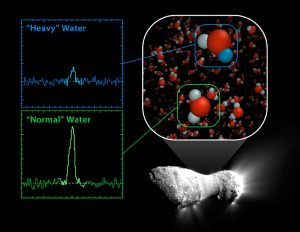| Basic Information | |
| What is this? | Comet 103P/Hartley 2 as seen by Herschel |
| Where is it in the sky? | Hartley 2 orbits the Sun in around 6.5 years |
| How big is it? | The nucleus of the comet is tiny, just 2 km across |
| How far away is it? | Hartley 2 has an elongated orbit that brings it in towards Earth and takes it out to beyond the orbit of Jupiter |
| What do the colours represent? | The inset image is the Herschel image of Comet Hartley 2, with the two lines showing the brightness of the emission from different types of water |
Downloads
See this object in:

Herschel Observations of Comet Hartley 2 have shown that it is made of water ice with a similar composition to Earth’s oceans. This adds weight to the theory that comets are the origin of the Earth’s oceans.
When the Earth formed in the early phases of the Solar System, around 4.5 billion years ago, it would have been a molten ball of rock. Any water present would have evaporated, leaving a dry lifeless world and begging the question: where did the oceans come from? This is a subject of much debate, with some scientists suggesting that the water condensed from a thick early atmosphere, and others promoting the idea that it was delivered by comets and asteroid that collided with the Earth.
Comets would seem to be very likely – they are, after all, made mostly of water ice. But previous measurements have indicated that the water in comets is of a different composition to that of the Earth’s oceans. Water is a molecule that combines hydrogen and oxygen, but the hydrogen can be replaced by a slightly equivalent version called deuterium. This “heavy” water is chemically the same, but the can be told apart by sensitive measurements of the light they emit.
These previous studies revealed that comets had around twice as much deuterium in as the Earth’s oceans, indicating that the water formed in different conditions from the Earth’s oceans. But Hartley 2 (official designation 103P/Hartley 2)is different to the comets we have examined before, having formed much further from the Sun. The HIFI instrument on-board Herschel was used to study Hartley 2, and found that the ratio of deuterium to hydrogen is the same as that in the Earth’s oceans.
The majority of comets we see are thought to have formed at roughtly the same distance from the Sun as Jupiter and Saturn, and then been flung out into the Oort cloud in the furthest reaches of the Solar System. They are sent back in to the inner solar system by interactions out in the cold depths of space. Hartley 2 is though to have formed in the Kuiper Belt, a region beyond the orbit of Neptune and in which objects like Pluto reside.
The Herschel measurements of Hartley 2 lend support to the idea that comets are responsible for much of the Earth’s water, though possibly only the comets that formed in the outer Solar System. Herschel is now studying more comets to see whether Hartley 2 is an odd one out, or whether similar comets show the same signature.
These observations were made as comet Hartley 2 made its closest apprach to Earth in late 2010. This was the same time that NASA’s EPOXI spacecraft made a flyby of the comet.


